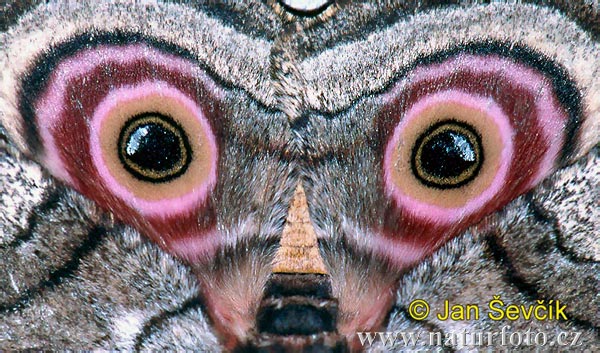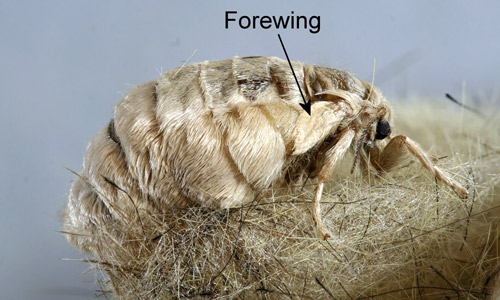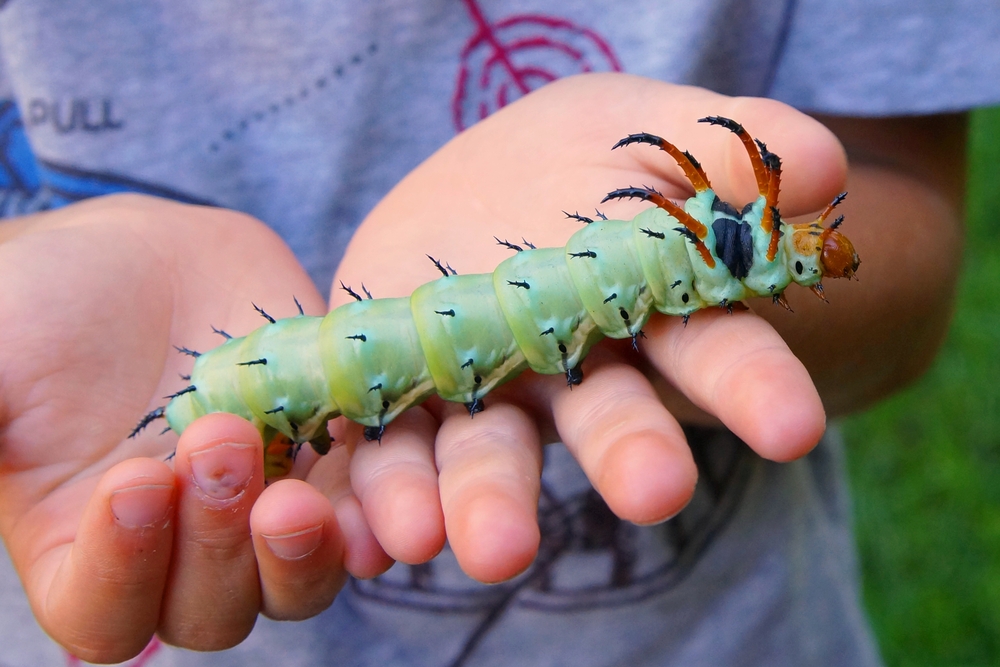jamesp
Cave Dweller 
Member since October 2012
Posts: 36,612
|
Post by jamesp on Sept 27, 2017 8:54:37 GMT -5
Are those white marshmallows on its back eggs? I noticed some have more. Odd that I think caterpillars are cute, or at least interesting, but moths give me the willies. Not eggs Pat, probably some kind of defense mechanism or camouflage. |
|
jamesp
Cave Dweller 
Member since October 2012
Posts: 36,612
|
Post by jamesp on Sept 27, 2017 9:00:58 GMT -5
Seen that Imperial moth fantastic5. It's a hand full. Most moths and butterflies in winged or larvae state have markings with serious intentions of camouflage or deception. Such as eyes on the back of their wings making predators think they are going to fly away backwards.   |
|
|
|
Post by Garage Rocker on Sept 27, 2017 9:48:04 GMT -5
Seen that Imperial moth fantastic5 . It's a hand full. Most moths and butterflies in winged or larvae state have markings with serious intentions of camouflage or deception. Such as eyes on the back of their wings making predators think they are going to fly away backwards.   Sweet Jesus, that's creepy! Poor Pat won't be able to sleep tonight. |
|
|
|
Post by Pat on Sept 27, 2017 10:21:58 GMT -5
Garage RockerEEEEEK! : ) I'll have to find something good about those moths! Those eyes are a good camouflage trick.
|
|
jamesp
Cave Dweller 
Member since October 2012
Posts: 36,612
|
Post by jamesp on Sept 27, 2017 10:32:58 GMT -5
Garage RockerEEEEEK! : ) I'll have to find something good about those moths! Those eyes are a good camouflage trick. Maybe Pat should not think about "Silence of the Lambs" before bedtime.... |
|
jamesp
Cave Dweller 
Member since October 2012
Posts: 36,612
|
Post by jamesp on Sept 27, 2017 10:39:09 GMT -5
|
|
|
|
Post by Garage Rocker on Sept 27, 2017 10:50:00 GMT -5
Garage Rocker EEEEEK! : ) I'll have to find something good about those moths! Those eyes are a good camouflage trick. Maybe Pat should not think about "Silence of the Lambs" before bedtime.... She probably shouldn't watch The Mothman Prophecies either!
Mothman wikipedia

|
|
|
|
Post by rockpickerforever on Sept 27, 2017 10:52:53 GMT -5
So you can brush your teeth with this caterpillar.  Good one James. Toothbrush - perfect analogy
You do NOT want to brush your teeth with that one, lol . The hairs, especially in the dorsal tussocks (the "toothbrush"), contain venom glands which can cause dermatitis and itching from contact with them.
Passages quoted from the Featured Creatures website, Medical Importance info linkThe medical importance of Orgyia species caterpillars is well-documented in the scientific (Diaz 2005, Gilmer 1925, Goldman et al. 1960, Knight 1922) and clinical dermatology (Hossler 2009 & 2010 ) literature. Pruritic (itching) dermatitis due to tussock moth caterpillars has been reported to be a problem at child day-care centers and elementary schools in Florida (Atrubin et al. 2012, Atrubin & Granger 2006, Cruse et al. 2007). Contact with the cocoons produces the same symptoms.
The caterpillars may be contacted when they drop from the host trees or when they wander from the trees in search of a place to spin their cocoons. Home owners develop dermatitis from contact with the cocoons while removing them from the soffits of houses. Hairs in the cocoons retain their urticating capability for up to a year or longer.
Most of the urticating hairs are in the dorsal tussocks of the caterpillars (Knight 1922), but a few are also found on the lateral verrucae and intermingled with the black plume hairs of the hair pencils (Gilmer 1925). Gilmer (1925) conducted histological studies of the urticating setae of Orgyia leucostigma and found that each seta has a venom gland at its base. The venom has not been adequately characterized.

Tussocks of the fir tussock moth (Orgyia detrita). (Inset: photomicrograph of antrose [distally projecting] barbs on urticating setae of the tussocks). Photograph by Donald W. Hall, University of Florida.

Diagram of urticating seta and associated venom gland of whitemarked tussock moth (Orgyia leucostigma). Redrawn from Gilmer (1925) by Jane C. Medley, University of Florida.
Morphology - Adults: Adults are dimorphic. Males are small, relatively dull-colored moths with prominent bipectinate antennae. At rest, they hold their first pair of legs in an outstretched position. The genus name Orgyia (Greek for “the length of the outstretched arms” [Borror 1960]), is based on this pose. Wingspreads of Orgyia species are 2.0-3.5 cm (0.78-1.4 in).
The literature frequently describes the females as being wingless. Actually, they are brachypterous (short-winged) but cannot fly. At present, females can be identified to species only by association with their respective larvae (or in the case of Florida Orgyia detrita by association with their egg masses).

Female fir tussock moth (Orgyia detrita). Photograph by Donald W. Hall, University of Florida. More on this website: entnemdept.ufl.edu/creatures/URBAN/MEDICAL/tussock_moths.htm
Hope you learned something, I certainly did!
|
|
|
|
Post by rockpickerforever on Sept 27, 2017 10:56:05 GMT -5
This is an excellent example, one of my favorites.

Their caterpillar is very distinctive as well.

And here is a really odd one, something to give Pat nightmares tonight: Hickory Horned Devil caterpillar

You guys have got me looking at strange bug photos online, lol.
|
|
jamesp
Cave Dweller 
Member since October 2012
Posts: 36,612
|
Post by jamesp on Sept 27, 2017 11:15:34 GMT -5
Good one James. Toothbrush - perfect analogy
You do NOT want to brush your teeth with that one, lol . The hairs, especially in the dorsal tussocks (the "toothbrush"), contain venom glands which can cause dermatitis and itching from contact with them.
More on this website: entnemdept.ufl.edu/creatures/URBAN/MEDICAL/tussock_moths.htm
Cool beans Jean. I did do a 'Wild Boyz' and rolled that thing around on the thick skin of my hand with no effects. I did NOT however roll it around on the tender skin of the inside of my arm. Thought about it, then thought better of it. General rule, if a caterpillar has hairs it will sting. Some quickly like a bee. Itch itch itch, not the same venom as a bee. Varied skin reactions, but usually a reaction. This one sure qualifies as a stinger. Sting similar to Cnidoscolus stimulosus , Florida Bull Neddle. And it will flat out set you on fire.  Close up of Bull Nettle poison bulb and sharp delivery points. One sting and you will be able to ID this plant in a jiffy.  |
|
jamesp
Cave Dweller 
Member since October 2012
Posts: 36,612
|
Post by jamesp on Sept 27, 2017 11:21:55 GMT -5
|
|
|
|
Post by rockpickerforever on Sept 27, 2017 11:36:11 GMT -5
Cool beans Jean. I did do a 'Wild Boyz' and rolled that thing around on the thick skin of my hand with no effects. I did NOT however roll it around on the tender skin of the inside of my arm. Thought about it, then thought better of it. General rule, if a caterpillar has hairs it will sting. Some quickly like a bee. Itch itch itch, not the same venom as a bee. Varied skin reactions, but usually a reaction. This one sure qualifies as a stinger. Sting similar to Cnidoscolus stimulosus , Florida Bull Neddle. And it will flat out set you on fire.  Close up of Bull Nettle poison bulb and sharp delivery points. One sting and you will be able to ID this plant in a jiffy.  Like you, I have pretty thick skin on my hands, to. Caluses. But the tender skin on the inside of my arm would take a serious hit. We have stinging nettle here too. That's one I always pull up (using gloves) should it appear in my yard with the early crop of weeds in spring. I can start getting the heebies and itching just looking at prickly things of that nature, lol. |
|
|
|
Post by fantastic5 on Sept 27, 2017 12:19:08 GMT -5
 Had to look this one up. Common to south eastern US. Can't believe I've never seen one. Can grow to the size of a hot dog! Turns dark as they age. And harmless. |
|
jamesp
Cave Dweller 
Member since October 2012
Posts: 36,612
|
Post by jamesp on Sept 27, 2017 16:55:50 GMT -5
I've never seen one either fantastic5. 26 years in the plant biz, bout seen them all. Not that one. At that size I would have remembered ! |
|
Deleted
Deleted Member
Member since January 1970
Posts: 0
|
Post by Deleted on Sept 27, 2017 17:32:32 GMT -5
 Had to look this one up. Common to south eastern US. Can't believe I've never seen one. Can grow to the size of a hot dog! Turns dark as they age. And harmless. Holy smokes sausages! |
|
|
|
Post by MrMike on Sept 27, 2017 19:34:36 GMT -5
Around here you have to be careful when picking corn, we call them pack saddles  |
|
Deleted
Deleted Member
Member since January 1970
Posts: 0
|
Post by Deleted on Sept 27, 2017 20:32:58 GMT -5
While clicksurfing around Google and learned the hickory bug star of this thread is available in egg form for between $7 and $15/ dozen. They grow on tree nut tree leaves.
|
|
|
|
Post by fantastic5 on Sept 28, 2017 7:14:01 GMT -5
Around here you have to be careful when picking corn, we call them pack saddles  I've seen these guys in my garden before. Really colorful! |
|
|
|
Post by Pat on Sept 28, 2017 9:10:50 GMT -5
Around here you have to be careful when picking corn, we call them pack saddles  Is that real? Looks like a small stuffed animal! |
|
jamesp
Cave Dweller 
Member since October 2012
Posts: 36,612
|
Post by jamesp on Sept 28, 2017 10:19:11 GMT -5
Around here you have to be careful when picking corn, we call them pack saddles  Is that real? Looks like a small stuffed animal! Ribs broken from laughing. Thanks for the morning lift Pat. |
|